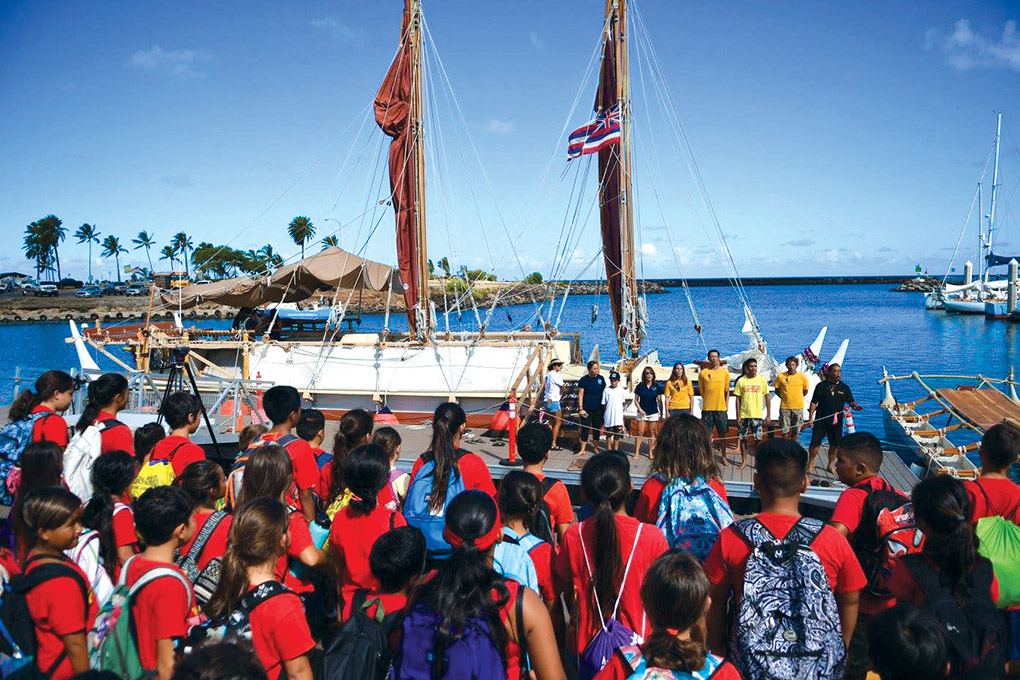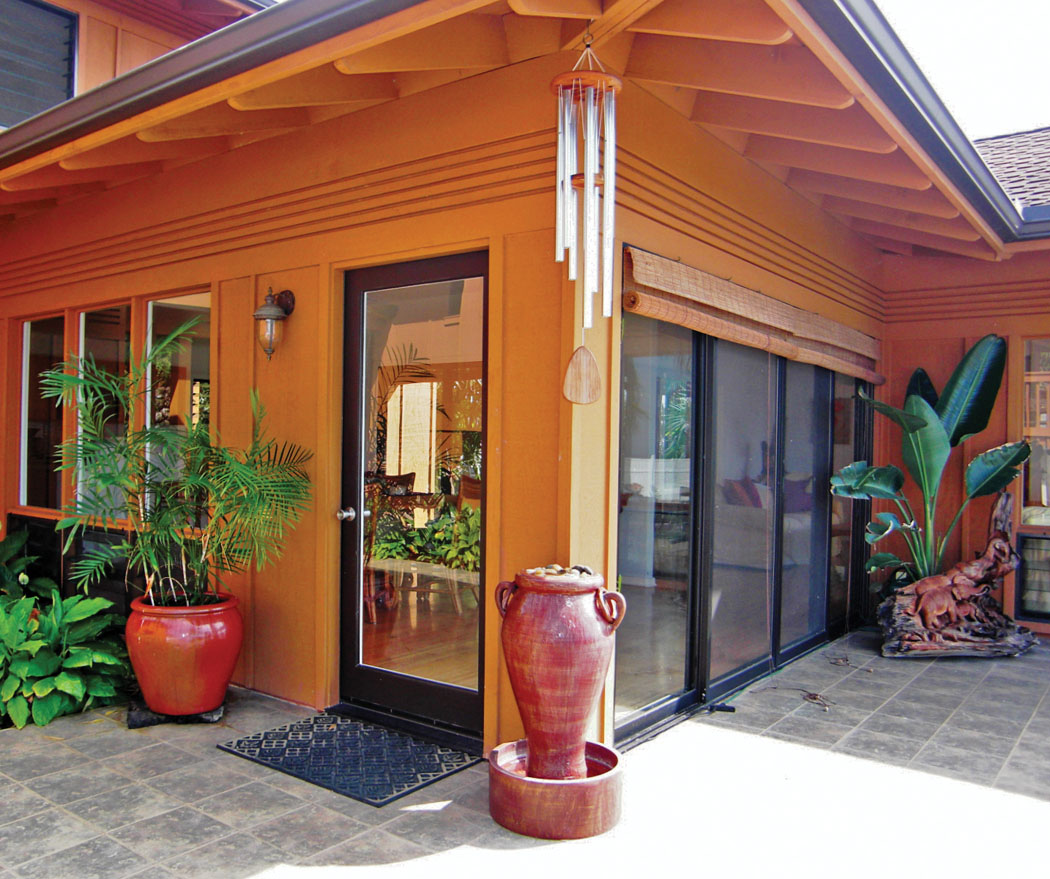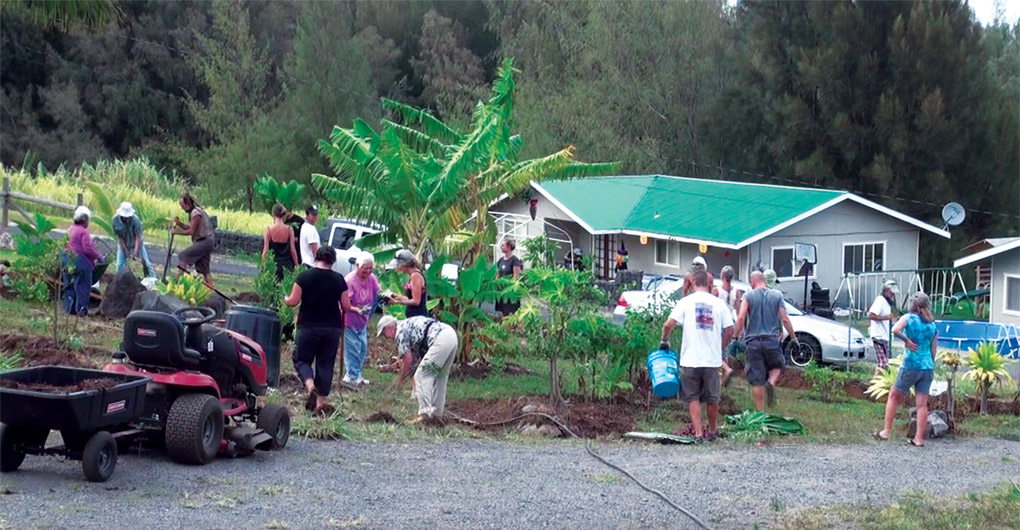
E Ala o Mahi‘ai: The Way of the Farmer
 By John J. Boyle
By John J. Boyle
Here at a crossroads of two cultures—one immediately challenged by serious food needs and another steeped in a culture of sustainability in exclusion—it is understood that the foods the first Polynesians brought with them on their canoes were the most nutritious and most exhaustive use of each plant they could carry.
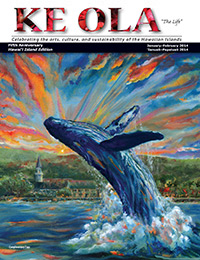
In a sometimes-daunting yet otherwise brilliant act, many of us are learning more about growing our food. In one of the world’s most ideal climates, those of us with access to land to garden are confronted by two questions: first, “What do we grow?” and second, “How do we grow it?”
Today, with the advent of agroforestry, great possibilities appear for the small home gardener as well as farmers. Forests and gardens are integrated in a small area, thereby producing maximum yield in a minimal space. It is ideal for the family gardener or weekend warrior of the soil. Much more can be done with attention to the process from seed to harvest—even when one lasts only a season while another will grow on for years.
Whether we are kama‘āina or malihini, we bring our own personal history and culture into our food preferences. Whatever country or climate we have a history with informs our choices and practices when it comes to embracing the work of growing.
When we catch wind of the GMO controversy, it is important to remember that the agribusiness is supposed to be doing their best in providing food for our burgeoning population demands. Unfortunately, agribusiness has made some unwise choices in the interest of mono-cropping and short-sighted use/abuse of the soil. The individual’s solution here is to regain control of one’s own food supply by growing it in a way that perpetuates the land for generations to come.
In Craig Elevitch’s book, Specialty Crops for Pacific Islands, he writes, “Agroforestry has been the primary land management system for food, fiber, fuel, and medicine production for thousands of years in the Pacific Islands.”
In October 2013, Craig and fellow expert M. Kalani Souza hosted a workshop, E Ala o Mahi‘ai, or the way of the farmer. In an effort to educate the community, they hope to revive the ancient practices by augmenting the soil with living soil and combining the growing of foods, wind breaks, and shade management.
Companionable Gardening
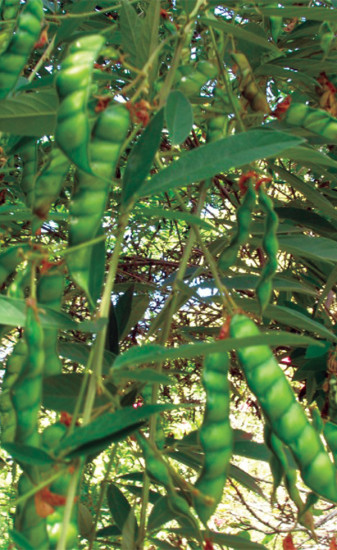
It’s early—just after 8am—on a Saturday at Hale Ho‘okipa Farm in Pa‘auilo, and Kalani and Craig’s workday workshop is already well underway. In and around the door to the kitchen buzzes a hive of activity: elders, mothers, children, and dogs joyfully swarming in preparation of a day promising productivity.
Kalani and Craig mix in and out as people bring out their gloves and tools and water bottles. Many different hands—calloused, soft, big and small—gather in a circle and a pule is offered. A circle of farmers, scientists, grandmothers, sisters and brothers rounds with individuals representing three islands and four corners of Hawai‘i Island. Each is interested in how to better grow food in the ancient tried and true way.
Kalani smiles and tells the group, “In my grandfather’s gardens we would be taking our break right now, already having been out on the land before the first light—weeding and doing hard digging in the coolest part of the day by the last of the moonlight.”
Kalani and Craig then point out side-by-side gardens. One was planted more than a year ago in a traditional western style layout with rows. The other was grown with the companionable poly-culture understanding. In the more segregated western style planting, wind and sun wear mark the plants. Although seemingly unorganized without rows or walkways (and more like clusters or little islands of food), the latter is a more tightly clustered and healthier collection of plants. There is a cluster of papayas and bananas bordered by pigeon peas and flanked with sweet potatoes. Each plant in the cluster helps out the other by providing shade and a barrier against the wind.
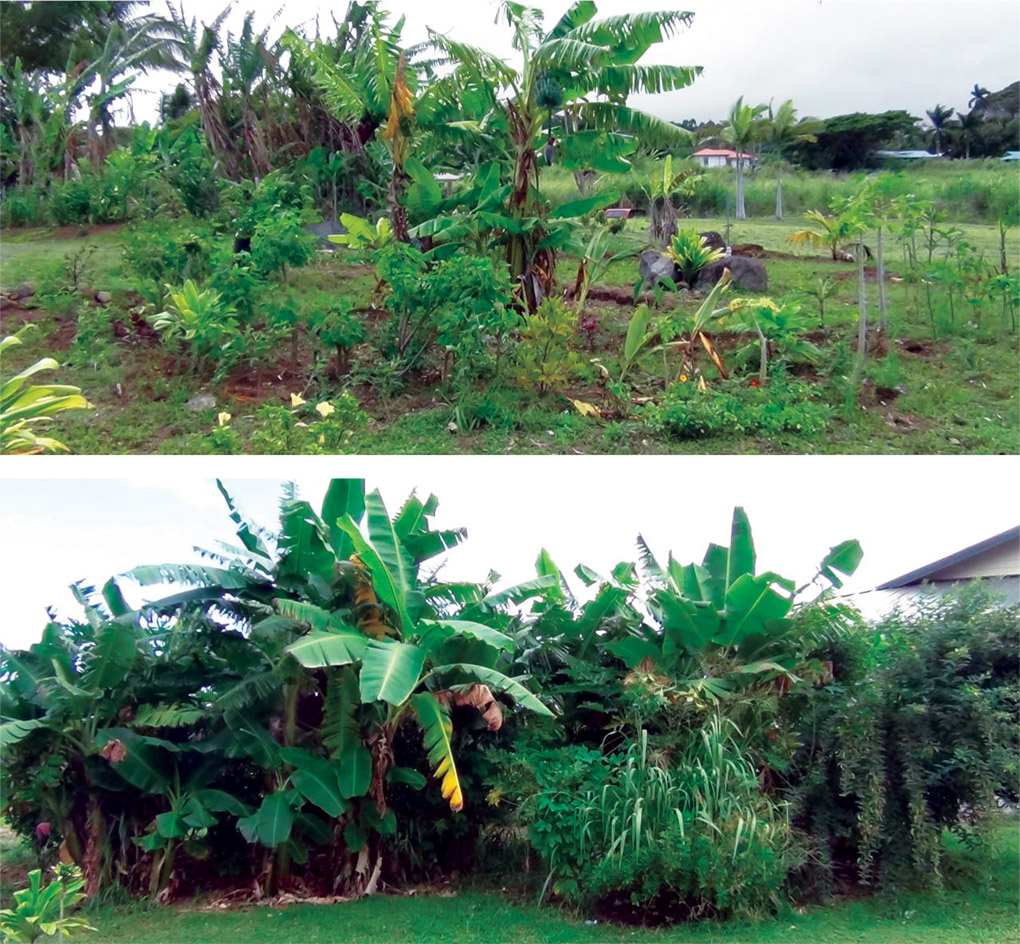
Transplants, Starts, and Swales
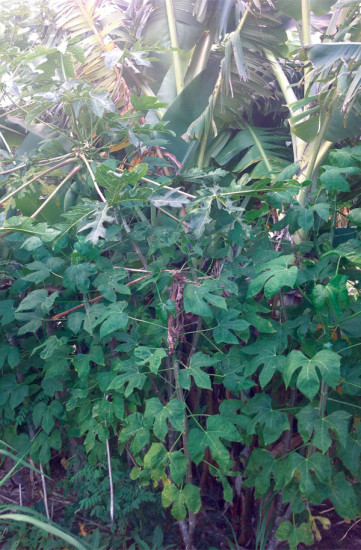
The main work of the day entails planting a new garden of taro, pigeon pea, sugar cane transplants and starts in what was once a depleted-plantation-scraped corner of the one-acre property—an area about 30 square feet. This involved creating a series of swales, or earthen mounds, that shunt and aim water flow.
Kalani explains, “Because we have had a dry summer, the heavy rains that are coming will flow on the top of the baked earth, and we need to decide where we want the water to go, bringing it to our food.”
This involves sensing the immanent flow of rainwater.
Kalani stands on the hill above the plantings and describes with musical hands the way the water may flow. Craig lines up a tripod plum line to get a reading on the leveling land. An ancient communication of understanding is shown with a gesture along with a modern scientific bit of data by a simple tool, thus validating both worlds of wisdom.
Out of the three-month food forest garden, already mature pigeon peas are gathered for eating and replanting. From sowing to reaping is only a matter of months for this nitrogen-fixing bush bean.
I walk into a kitchen stewing and brewing with delights all from the immediate land: taro, papaya, mango, banana, oranges, liliko‘i, breadfruit, and cassava becoming our food for the day. A local Japanese woman brings her ‘ulu coconut balls and homemade umeboshi. Someone else shares a chicken from down the road. It is a feast for the eyes—not just the mouth.
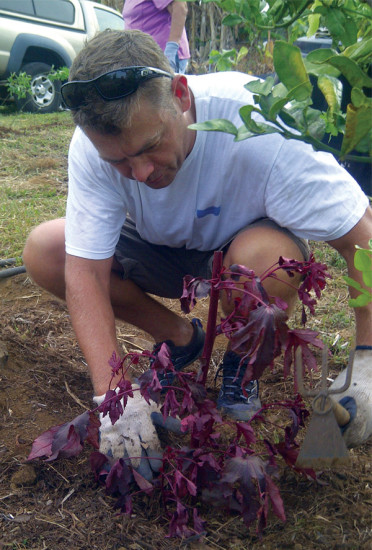
This display represents an immediate example of the monoculture design blended with traditional Polynesian sensibility. The proof is in the pudding: more and various foods are growing in the same sized area in a far shorter time. Companion planting happens below the surface as well.
The soil is augmented with composts and introduced indigenous microorganisms, some of which show thin white hairs of a bio system barely visible to the eye. We know to like worms and grubs and how they transform organic compost into soil-accessible nutrients. In this living soil thrive a myriad of microscopic plant and animal matter, which is essential to plant health at the root processing level.
In a western style garden, some organisms will arrive eventually, sometimes after seasons without herbicides and pesticides. These are the living things that make up the nutrients for our food. Generally, the yield is less in poly-culture growing, but the variety is greater and the total production is higher for a smaller garden. ❖
The next class in E Ala o Mahi‘ai series will be Jan 31–Feb 2. Contact Julie Stowell for more details 808.776.1077.
Contact M. Kalani Souza: MKalani.com
Contact Craig Elevitch: AgroForestry.net
Contact writer John J. Boyle: jjjboyle2112@gmail.com
Craig Elevitch is Director of Permanent Agriculture Resources and Project Coordinator, responsible for all aspects of planning, coordination, and logistics. Since 1989, he has worked in agroforestry design, management, and education. His projects focus on multipurpose trees that have economic, environmental, and cultural significance. He also directs Agroforestry.net, a nonprofit educational organization dedicated to empowering people in agroforestry and ecological resource management. The organization’s internationally recognized publications have guided thousands of readers in developing agroforestry systems, ecological restoration, and reforestation on farms, ranches, home gardens, and conservation areas. Publications include Agroforestry Guides for Pacific Islands (2000), Growing Koa: A Hawaiian Legacy Tree (2003), Traditional Trees of Pacific Islands: Their Culture, Environment, and Use (2006), Noni: The Complete Guide for Consumers and Growers (2006), Pathways to Abundant Gardens: A Pictorial Guide to Successful Organic Growing (2007), and Specialty Crops for Pacific Islands (2011).
Rev. M. Kalani Souza is a gifted storyteller, singer, songwriter, musician, performer, poet, philosopher, priest, political satirist, and peacemaker. A Hawaiian practitioner and cross-cultural facilitator, he has experience in promoting social justice through conflict resolution. His workshops and lectures inspire, challenge and entertain the listener while calling all to be their greater self.
